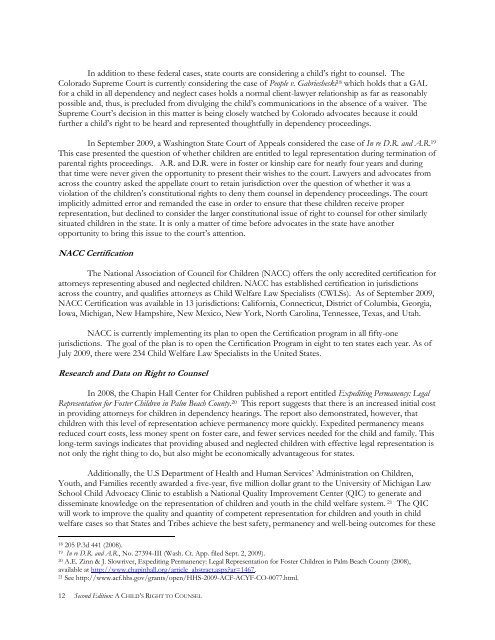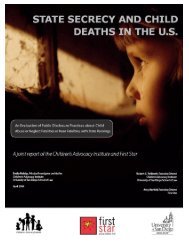A CHILD'S RIGHT TO COUNSEL - Children's Advocacy Institute
A CHILD'S RIGHT TO COUNSEL - Children's Advocacy Institute
A CHILD'S RIGHT TO COUNSEL - Children's Advocacy Institute
- No tags were found...
You also want an ePaper? Increase the reach of your titles
YUMPU automatically turns print PDFs into web optimized ePapers that Google loves.
In addition to these federal cases, state courts are considering a child‘s right to counsel. TheColorado Supreme Court is currently considering the case of People v. Gabriesheski 18 which holds that a GALfor a child in all dependency and neglect cases holds a normal client-lawyer relationship as far as reasonablypossible and, thus, is precluded from divulging the child‘s communications in the absence of a waiver. TheSupreme Court‘s decision in this matter is being closely watched by Colorado advocates because it couldfurther a child‘s right to be heard and represented thoughtfully in dependency proceedings.In September 2009, a Washington State Court of Appeals considered the case of In re D.R. and A.R. 19This case presented the question of whether children are entitled to legal representation during termination ofparental rights proceedings. A.R. and D.R. were in foster or kinship care for nearly four years and duringthat time were never given the opportunity to present their wishes to the court. Lawyers and advocates fromacross the country asked the appellate court to retain jurisdiction over the question of whether it was aviolation of the children‘s constitutional rights to deny them counsel in dependency proceedings. The courtimplicitly admitted error and remanded the case in order to ensure that these children receive properrepresentation, but declined to consider the larger constitutional issue of right to counsel for other similarlysituated children in the state. It is only a matter of time before advocates in the state have anotheropportunity to bring this issue to the court‘s attention.NACC CertificationThe National Association of Council for Children (NACC) offers the only accredited certification forattorneys representing abused and neglected children. NACC has established certification in jurisdictionsacross the country, and qualifies attorneys as Child Welfare Law Specialists (CWLSs). As of September 2009,NACC Certification was available in 13 jurisdictions: California, Connecticut, District of Columbia, Georgia,Iowa, Michigan, New Hampshire, New Mexico, New York, North Carolina, Tennessee, Texas, and Utah.NACC is currently implementing its plan to open the Certification program in all fifty-onejurisdictions. The goal of the plan is to open the Certification Program in eight to ten states each year. As ofJuly 2009, there were 234 Child Welfare Law Specialists in the United States.Research and Data on Right to CounselIn 2008, the Chapin Hall Center for Children published a report entitled Expediting Permanency: LegalRepresentation for Foster Children in Palm Beach County. 20 This report suggests that there is an increased initial costin providing attorneys for children in dependency hearings. The report also demonstrated, however, thatchildren with this level of representation achieve permanency more quickly. Expedited permanency meansreduced court costs, less money spent on foster care, and fewer services needed for the child and family. Thislong-term savings indicates that providing abused and neglected children with effective legal representation isnot only the right thing to do, but also might be economically advantageous for states.Additionally, the U.S Department of Health and Human Services‘ Administration on Children,Youth, and Families recently awarded a five-year, five million dollar grant to the University of Michigan LawSchool Child <strong>Advocacy</strong> Clinic to establish a National Quality Improvement Center (QIC) to generate anddisseminate knowledge on the representation of children and youth in the child welfare system. 21 The QICwill work to improve the quality and quantity of competent representation for children and youth in childwelfare cases so that States and Tribes achieve the best safety, permanency and well-being outcomes for these18 205 P.3d 441 (2008).19 In re D.R. and A.R., No. 27394-III (Wash. Ct. App. filed Sept. 2, 2009).20 A.E. Zinn & J. Slowriver, Expediting Permanency: Legal Representation for Foster Children in Palm Beach County (2008),available at http://www.chapinhall.org/article_abstract.aspx?ar=1467.21 See http://www.acf.hhs.gov/grants/open/HHS-2009-ACF-ACYF-CO-0077.html.12 Second Edition: A CHILD‘S <strong>RIGHT</strong> <strong>TO</strong> <strong>COUNSEL</strong>






